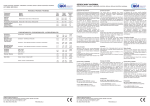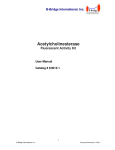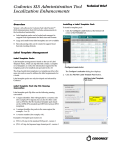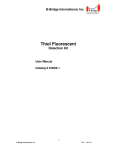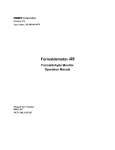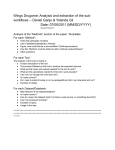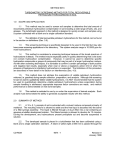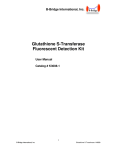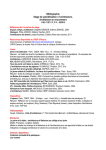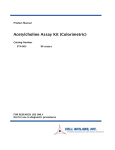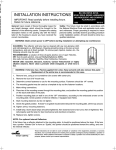Download Butyrylcholinesterase - B-Bridge International, Inc.
Transcript
B-Bridge International, Inc. Butyrylcholinesterase Fluorescent Activity Kit User Manual Catalog # K3016-1 1 B-Bridge International, Inc. Butyrylcholinesterase 110811 TABLE OF CONTENTS Intended Use 3 Background 3 Assay Principle 3 Kit Components 4 Materials Required 4 Precautions 4 Reagent Preparation 5 Sample Preparation 6 Assay Protocol 6 Calculations 6 Typical Standard Curve: Example 7 Notice to Purchaser This product is to be used for Research Purposes Only. It is not to be used for Drug or Diagnostic Purposes, nor is it intended for Human Use. B-Bridge products may not be resold, modified for resale, or used to manufacture commercial products without the express written consent of B-Bridge International, Inc. EXCEPT AS OTHERWISE EXPRESSLY SET FORTH IN THIS USER MANUAL, B-BRIDGE DOES NOT MAKE ANY REPRESENTATION OR WARRANTIES OR CONDITIONS OF ANY KIND, EITHER EXPRESSED OR IMPLIED, WITH RESPECT TO THE PRODUCTS, OR INFORMATION DISCLOSED HEREUNDER, INCLUDING, BUT NOT LIMITED TO, THE IMPLIED WARRANTIES OF MERCHANTABILITY, FIT FOR A PARTICULAR PURPOSE, OR NONINFRINGEMENT OF THE INTELLECTUAL PROPERTY RIGHTS OF THIRD PARTIES. B-Bridge International, Inc. All Rights Reserved. 2 B-Bridge International, Inc. Butyrylcholinesterase 110811 INTENDED USE The B-Bridge Butyrylcholinesterase Fluorescent Activity Kit (cat.# K3016-1) quantitatively measures Butyrylcholinesterase activity in serum and EDTA and heparin plasmas from a variety of species. This assay is species independent. It will also measure BChE in extracted tissue samples and cell lysates. BACKGROUND Butyrylcholinesterase (BChE) belongs to the same structural class of proteins as acetylcholinesterase (AChE). The 440kDa tetrameric glycoprotein is predominantly found in blood, kidneys, intestine, liver, lung, heart and the central nervous system. Many species, such as human, horse and mice exhibit high BChE activity in plasma, whereas rats have higher acetylcholinesterase activity in plasma. BChE preferentially acts on butyrylcholine, but also hydrolyzes acetylcholine. BChE BChE serves a few known functions within the body. As a detoxification enzyme, it hydrolyzes ester-containing drugs and scavenges cholinesterase inhibitors, such as succinylcholine, before they have a chance to reach synaptic targets. By doing this, the enzyme minimizes the neuromuscular effect these agents have. A deficiency of BChE can result in delayed metabolism of various drugs, such as cocaine, and treatment with doses of BChE can help in overcoming the physiological reaction to them. As an activator enzyme, BChE converts administered prodrugs into functional therapeutics. Bambuterol is a prodrug with anti-asthmatic properties after being converted by BChE. BChE is the only enzyme in human serum that acts on heroin, and its end product, after crossing the blood-brain barrier, is hydrolyzed to morphine by enzymes in the brain. Alzheimer’s disease involves the degeneration of cholinergic neurons and loss of cholinergic transmission. The reduction in choline acetyltransferase leads to a decrease in acetylcholine and acetylcholinesterase activity, which appears to cause an increase in BChE activity. Potent cholinesterase inhibitor therapeutics protect the limited acetylcholine levels, acting on both AChE and BChE. Selective BChE inhibitors prevent the formation of new beta-amyloid plaques, which are created by BChE cleaving amyloid precursor protein to beta-amyloid protein. BChE-positive neurons project to the frontal cortex portion of the brain. BChE may have roles in attention, executive function, emotional memory and behavior. As dementia advances, BChE activity has been shown to increase, while AChE activity decreases, leaving the potential for BChE activity to be used as a biomarker for progression or target for future therapies. ASSAY PRINCIPLE The Butyrylcholinesterase Fluorescent Activity kit is designed to quantitatively measure butyrylcholinesterase (BChE) activity in a variety of samples. The kit utilizes a proprietary non-fluorescent molecule, Thio, that covalently binds to the thiol product of the reaction between the BChE Substrate and BChE in the standards or samples, yielding a fluorescent product read at 510 nm in a fluorescent plate reader with excitation at 390 nm. The readout of BChE activity is purely chemical; there are few interferants that will affect the readings obtained. 1. Sample or standard added to well. 2. The reaction is initiated with the addition of the Reaction Mix containing BChE, Substrate, and Thio Detection Reagent 3. Incubate for 20 minutes and read fluorescent signal. Calculate BChE activity from standard curve. 4. Alternatively samples can be read kinetically. Follow steps 1 and 2 above. Add Reaction Mix and read signal at 510 nm over time. Compare rates for samples and standards to determine sample BChE activity. 3 B-Bridge International, Inc. Butyrylcholinesterase 110811 KIT COMPONENTS Black 96-well plates 2 plates Butyrylcholinesterase Standard (BChE) - 200 mU/ml 225 µl Thio Detection Reagent - Stored in desiccator 2 vials BChE Substrate 2 vials - Butyrylthiocholine iodide freeze dried with stabilizers Dimethyl Sulfoxide Solvent (DMSO) 14 ml - DMSO will freeze at 2-8°C. Store tightly capped at room temperature. 10X Assay Buffer 28 ml Store all components at 2-8°C, except DMSO. Store DMSO tightly capped at room temperature. MATERIALS REQUIRED BUT NOT SUPPLIED - Deionized or distilled water - Fluorescence 96-well plate reader capable of reading fluorescent emission at 510 nm with excitation at 390 nm. -Software for converting raw relative fluorescent unit (FLU) readings from the plate reader and carrying out four parameter logistic curve (4PLC) fitting. . PRECAUTIONS This kit should only be used by qualified personnel who have had laboratory safety instruction. The complete User Manual should be read and understood before using this product. Dimethyl sulfoxide (DMSO) is a powerful aprotic organic solvent that has been shown to enhance the rate of skin absorption of skin-permeable substances. Wear protective gloves, safety glasses and clothing when working with DMSO. Consult your institution’s safety procedures for working with hazardous chemicals. The Butyrylcholinesterase Standard is derived from human blood. It has been extensively tested for viral contamination, but all human blood products should be treated as potentially infectious and adequate precautions taken. Protective clothing, gloves, and safety glasses should be worn. Consult your institution’s safety procedures for working with human samples. Thio Detection Reagent should be stored at 4°C in the desiccator. Allow the desiccator to warm to room temperature prior to opening. Thio Detection Reagent will react with strong nucleophiles. Buffers containing the preservatives sodium azide, Proclin™ and Kathon™ will react with the substrate. 4 B-Bridge International, Inc. Butyrylcholinesterase 110811 REAGENT PREPARATION Allow the kit reagents to come to room temperature for 30 minutes. We recommend that all standards and samples be run in duplicate to accurately determine BChE activity. Ensure that all samples have reached room temperature and have been diluted as appropriate prior to assaying. 1X Assay Buffer Prepare a 1X Assay Buffer by diluting 1 part 10X Assay Buffer with 9 parts deionized water. 1X Assay Buffer is stable for up to 3 months at 4°C. 10X Thio Detection Reagent Make a 10X Thio Detection Reagent by adding 700 µl of DMSO to 1 vial of Thio Reagent, vortex thoroughly. Store any unused reconstituted Detection Reagent at 4°C in the desiccator and use within 2 weeks. 10X Butyrylcholinesterase Substrate Make a 10X BChE Substrate Reagent by adding 700 µl of DMSO to 1 vial of BChE Substrate, vortex thoroughly. Store any unused reconstituted BChE Substrate at room temperature and use within 2 weeks Reaction Mix Follow the table below to make the appropriate volume of Reaction Mix. Use the Reaction Mix within 1 hour of preparation. Protect from light. Half Plate 300 µl 300 µl 2.4 ml 10X BChE Substrate 10X Thio Detection Reagent DMSO Whole Plate 550 µl 550 µl 4.4 ml Standard Preparation BChE Standards are prepared by labeling seven test tubes as #1 through #7. Briefly spin vial of standard in a microcentrifuge to ensure contents are at bottom of the vial. Pipet 450 µl of 1X Assay Buffer into tube #1 and 250 µl into tubes #2 to #7. Carefully add 50 µl of the BChE Standard to tube #1 and vortex completely. Take 250 µl of the BChE solution in tube #1 and add it to tube #2 and vortex completely. Repeat these serial dilutions for tubes #3 through #7. The activity of BChE in tubes 1 through 7 will be 20, 10, 5, 2.5, 1.25, 0.625 and 0.313 mU/ml. Use all standards within 2 hours of preparation Reagent Assay Buffer Volume BChE Standard Standard 1 Standard 2 Standard 3 Standard 4 Standard 5 Standard 6 Final Concentration (mU/mL) Standard 1 450 µl 50 µl Standard 2 250 µl Standard 3 250 µl Standard 4 250 µl Standard 5 250 µl Standard 6 250 µl Standard 7 250 µl 250 µl 250 µl 250 µl 250 µl 250 µl 250 µl 20 10 5 2.5 1.25 0.625 0.313 5 B-Bridge International, Inc. Butyrylcholinesterase 110811 SAMPLE PREPARATION Store serum or plasma on ice until assaying or freeze in aliquots for later use. Samples containing visible particulate should be centrifuged prior to using. Samples must be diluted in 1X Assay Buffer prior to assaying. Human serum and plasma typically have to be diluted ≥ 1:300 to read in the assay. Any samples with BChE activity outside the standard curve range should be diluted further with 1X Assay Buffer to obtain readings within the standard curve. Use all samples within 2 hours of dilution ASSAY PROTOCOL Standards and samples should be run in duplicate 1. Use a plate layout sheet to properly identify samples and standards. 2. Pipet 100 µl of samples or standards into duplicate wells in the plate 3. Pipet 100 µl of 1X Assay Buffer into duplicate wells as a zero standard. 4. Add 50 µl of prepared Reaction Mix to each well using a repeater or multi-channel pipet 5. Gently tap the sides of the plate to mix the reagents. 6. Incubate at room temperature for 20 minutes 7. Read the fluorescent emission at 510 nm with excitation at 370-410 nm. CALCULATIONS Average the duplicate fluorescent unit (FLU) readings for each standard and sample. Create a standard curve by reducing the data using the 4PLC (4 parameter logistic curve) fitting routine on the plate reader, after subtracting the mean FLU for the zero standard. The sample activity obtained should be multiplied by the dilution factor to obtain neat sample values. 6 B-Bridge International, Inc. Butyrylcholinesterase 110811 TYPICAL STANDARD CURVE: EXAMPLE ONLY Standard curves vary with each assay. Always run your own standard curves for calculation of results; do not use this data 7 B-Bridge International, Inc. Butyrylcholinesterase 110811







